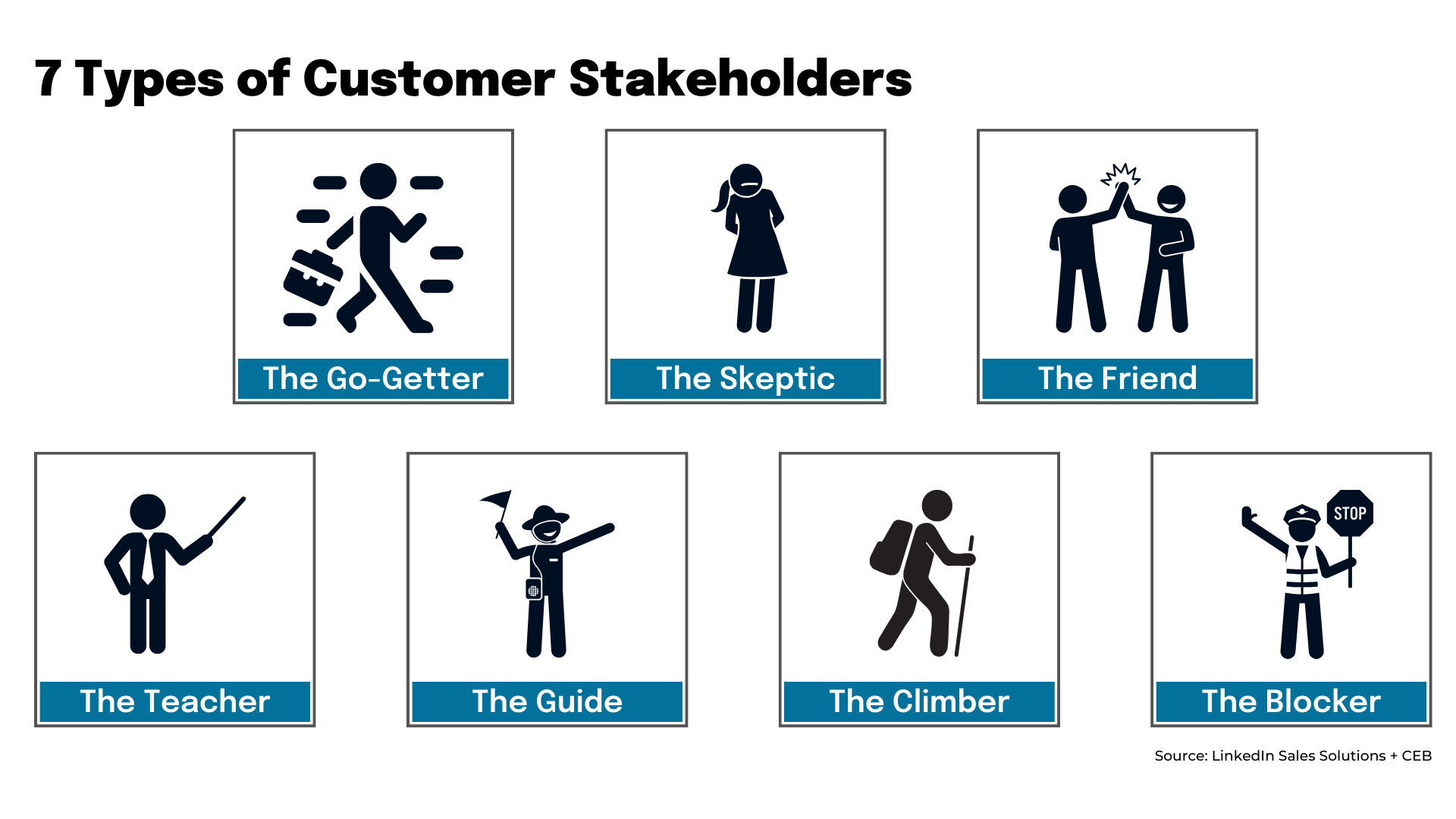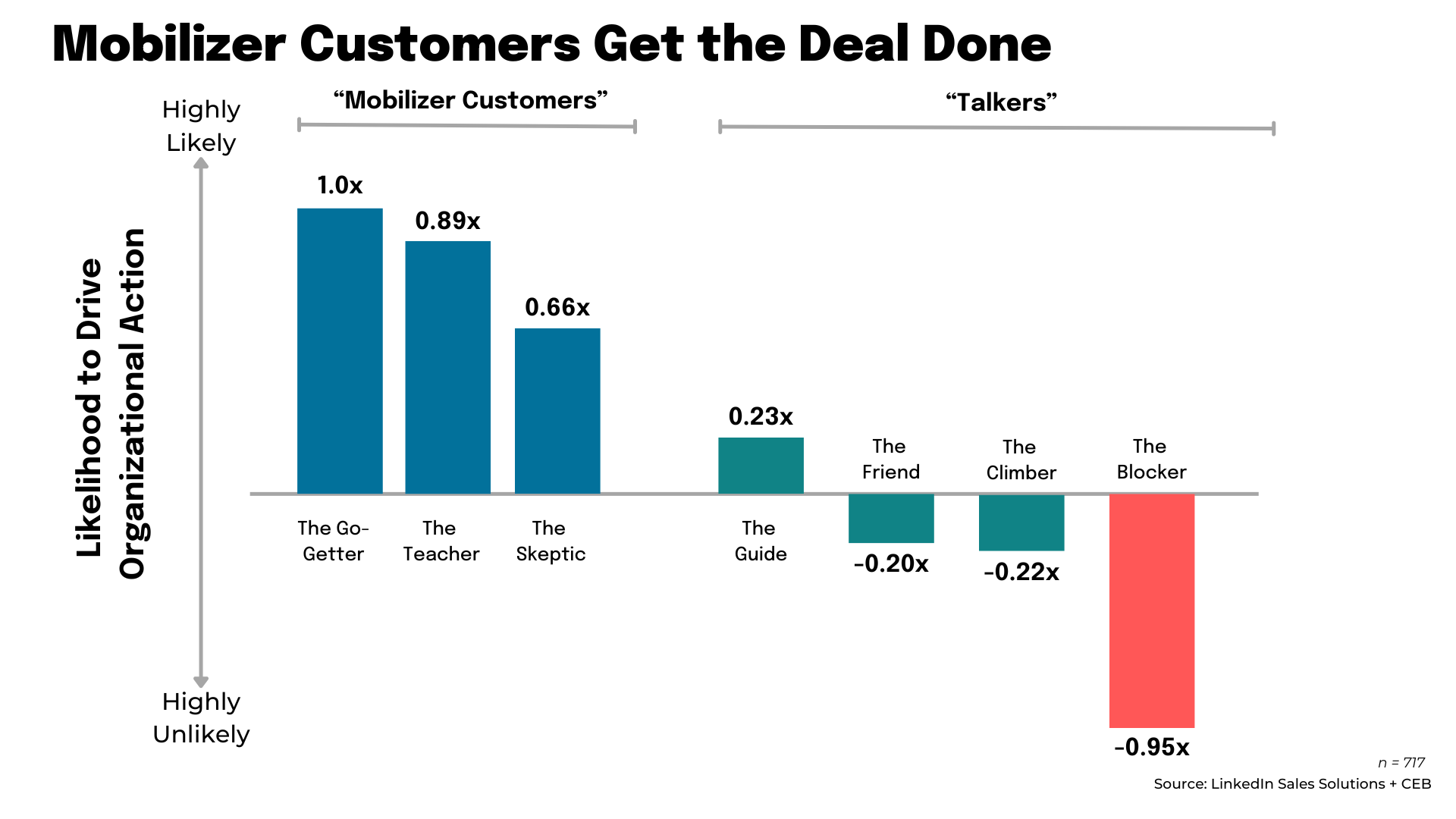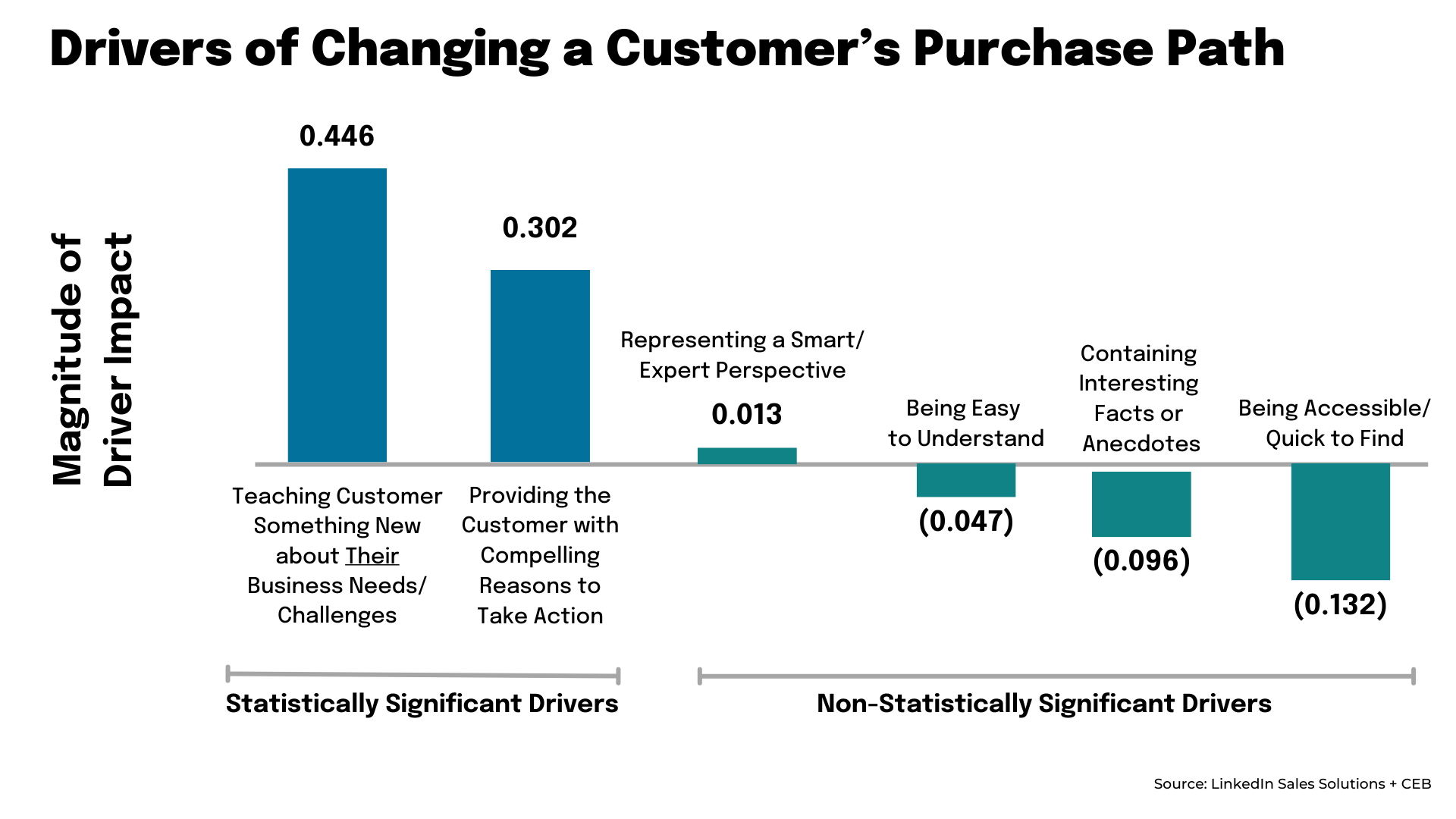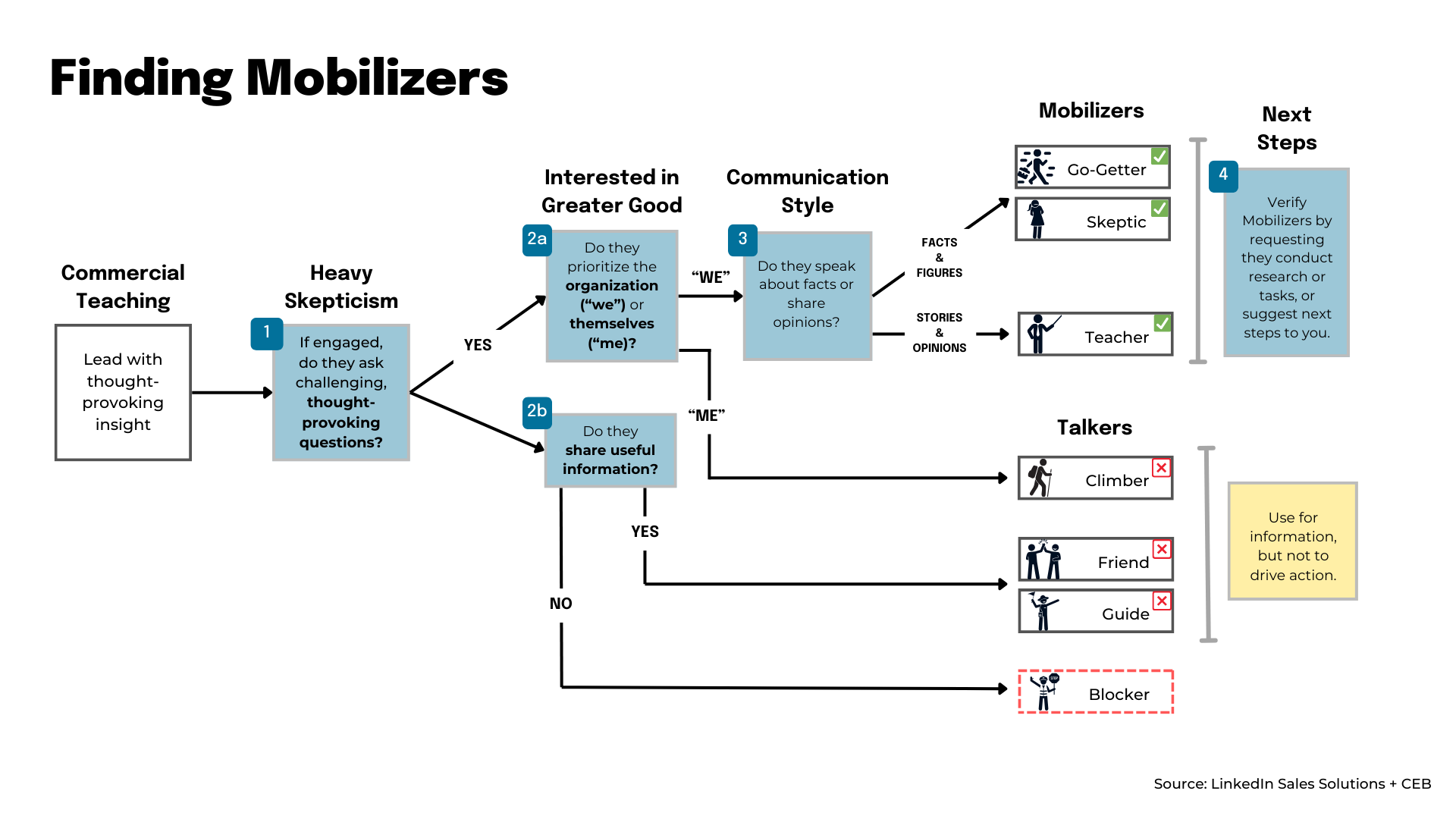⚡️ Today’s level up ⚡️
Today’s edition focuses on helping you identify and connect with the one true influencer who will help unlock a transformation deal.
Let’s go!
Read time: <9 minutes
If you missed last week, read it here.
Let’s get clear on “champion”
If you only have one champion in your transformation deals, you’re screwed. I see this peddled on LinkedIn every day: “You need to rely on a champion to get the deal over the line.”
Wrong!
You need multiple champions if you want your initiative to be taken seriously and your complex deal to land with a Fortune 500 company.
But you do need just one “Mobilizer.” They are the champion of all champions.
I was handed the book The Challenger Customer when I started my first Strategic Account role with LivePerson in 2018.

It’s a follow-on to the wildly popular The Challenger Sale and is a part of a series of books from Matthew Dixon and other contributing authors (The Effortless Experience and The Jolt Effect are the other two books).
It came out in 2016, but it’s just as applicable today as it was then (although there are more than the average of 5.4 stakeholders involved in deals, as they found back then). The authors analyzed over 3,000 complex B2B deals to develop their approach.
“Much of the problem lies less in a supplier organization’s inability to sell effectively and far more in a customer organization’s inability to buy effectively.”
The book’s central thesis is that the key to successful sales in these environments is not just about finding the right customer, but about finding the right challenger customer.
These are the individuals within an organization who are change-oriented, have a significant influence over the purchasing process, and are capable of driving consensus among their colleagues for making ambitious buying decisions.
Our strat account team designed our buying experience around the principles of this approach. I took it a step further to understand this key influencer by deeply studying our most innovative customer. That effort was influential in my ability to close $27.3M ARR in less than 4 years.
For a company that is currently valued at $615.25M, that meant my accounts’ contributions equated to a lift in Enterprise Value (EV) of $163.8M on the low end and $409.5M on the high end (Enterprise Value = ARR x EV/ARR Multiple. Typical multiples for SaaS companies could be anywhere from 6x to more than 15x).
That’s serious value, so who you’re selling with matters.
I’ll summarize how the authors break down finding the right Mobilizer. I found this strategy (along with four other elements), to be the key to unlocking large transformation deals in SaaS.
Understanding the types of customer stakeholders

According to their research of analyzing over 700 customer profile types of large deals, they found that there are seven types of customer stakeholders. In Matt Dixon’s exact words, they are:
1. THE “GO-GETTER”
This person is all about organizational improvement. She’s constantly looking for good ideas and champions them when she finds them— no matter where they come from.
What’s more, she delivers results. This person is the project manager, the pragmatist, the one who immediately starts translating new opportunities into work plans, key deliverables, implementation milestones, and success metrics. When sitting down with the Go-Getter, she will immediately focus on the how of what you’re proposing as opposed to the why of what you’re proposing.
2. THE “SKEPTIC”
In contrast to the Go-Getter, the Skeptic is more focused on the why behind a change proposal and will hold a high bar in terms of burden of proof. The Skeptic pushes back on everything and will often start from the assumption that the change you’re talking about isn’t going to go as planned— the one whose first reaction to a new idea or opportunity is “Let me explain why that isn’t going to work here” or “You know, the last time we tried something like this, it took twice as long, cost twice as much, and delivered half the benefit we expected.”
Mind you, it’s not because he’s annoying, but because he’s wary of large, complicated projects and tends to take a “glass-half-empty” perspective on the benefits of a given solution, as described by the salesperson. It’s typically not because the Skeptic finds the salesperson deceitful, but rather because he doubts his organization can fully realize the benefits of the change. As a result, the Skeptic tends to need a lot of convincing and is especially careful to lay the groundwork and set expectations in order to ensure a successful, measured implementation.
3. THE “FRIEND”
Just as nice as they sound, the Friend is readily accessible to reps and willingly networks reps with other stakeholders across the organization. These folks always make time to meet with outside salespeople— whether out of professional courtesy or a genuine interest in expanding their own networks, they are characterized by an openness and willingness to make time for meeting with salespeople. Whereas the vast majority of customers never respond to e-mails or voicemails left by salespeople, the Friend would never deign to be so inconsiderate.
4. THE “TEACHER”
The Teacher is all about sharing insights and ideas. Colleagues seek her out for her advice and input. She’s good at convincing others to pursue a course of action. Because of their unique storytelling and communication abilities, these people are frequently tapped to help senior leadership craft their own messages. They are the “Blue Ocean Strategy” folks within the customer organization— they love to paint a bold, aggressive vision and see others get as enthused about it as they are. Passion and excitement are the currency of the Teacher.
5. THE “GUIDE”
The Guide willingly provides information typically unavailable outside the customer organization. Their stock in trade is information, plain and simple. They use the information (especially confidential, privileged information) to enhance the perception others have of them (the thinking being that if others see them as “in the know,” they’ll perceive them as being more senior and important than perhaps the title on their business card suggests). Because of this, they’re best thought of as the “oversharers” of the customer organization— the ones who dish the dirt and catch you up on the latest comings and goings of various players inside the company (often sharing information about colleagues and internal politics that makes outsiders a bit uneasy).
6. THE “CLIMBER”
The Climber is focused almost entirely on personal gain. These are the “skin in the game” stakeholders who actively back projects that raise their profile, increase their influence, or expand their fiefdoms. When they back a project or initiative, they do so out of the belief that— if it goes well— they will be rewarded for their success. The Climber also likes to brag about past successes and accomplishments.
7. THE “BLOCKER”
Finally, we have what might be considered the “antistakeholder.” The “Blocker” is wired to avoid change and defend the status quo. They strongly prefer stability and continuity, actively avoiding (and preventing) initiatives that would bring change and disruption. As a result, they rarely help suppliers and almost never go out of their way to speak to outside vendors. Whether they block for personal reasons (e.g., being burned by suppliers in the past or being the person who invented the legacy system or approach) or because they are “pro status quo,” it makes little difference. While it’s critical to identify and manage Blockers (something we’ll talk about later in the book), for the sake of this discussion, we need to throw them out of the mix. Because of how they’re wired, they will never be the stakeholder a salesperson will hitch their wagon to.
Now that we know the different types of stakeholders you’ll encounter in your deal pursuits, it’s key to understand which ones will be best equipped to sell with you and get your transformation deal over the line. According to their research, the seven stakeholders can be grouped into two main categories:
– Mobilizers
– Talkers
As you can see in the chart below, the three types of Mobilizers are:
– The Go-Getter
– The Teacher
– The Skeptic
The other four are Talkers, with obviously The Blocker being the stakeholder who is least likely to drive organizational action.
I won deals with all three types of Mobilizers, and each requires a slightly different approach to gain consensus.

Finding and attracting Mobilizers
The authors argue that the best way to engage with Mobilizers is not through thought leadership but through proactive commercial insights.
This is absolutely my experience in every strategic deal I won. Mobilizers are too busy to waste time reading about how great your solution is and instead need to be presented with different and better ways that their businesses can operate.
Here’s their research.

Teaching a customer something new about their business needs/challenges is 45% more impactful than thought leadership (representing a smart/expert perspective) for instance. That’s significant because what I experienced and still see today is sellers pushing out all of their Marketing’s fancy one-sheets and infographics. That’s a wasted effort.
But to connect with a Mobilizer, you need to teach them something new with a commercial insight about their business and a compelling reason for them to act now.

At LivePerson, I used tools like an industry Maturity Model and category design to state bold things like “Will you be in a position to shut down your 1-800 number in the next three years? Imagine being the first airline to never have to put your customers on hold again during a winter storm. We have brands who are going fully conversational and some innovative contact center leaders are working towards doing it in the next twelve months in other industries.”
This was the emotional connection that spurred a logical discussion on how.
Here’s the four-step process to finding, attracting, and working with Mobilizers:
Step 0: Always lead with a thought-provoking insight
→ Use the Simple Strategic Sales System if you need help
Step 1: Once engaged, be prepared and ok with heavy skepticism. You want to see if they are asking you challenging and thought-provoking questions.
Step 2a: If yes, you need to determine if they are interested in the greater good (”we”) or just themselves (”me”).
Step 2b: If they are only interested in themselves, you’re likely dealing with a Climber. Get information from them that you can use.
Step 3: Do they speak in facts or share opinions…or do they prefer to just talk about fun stuff, gossip, or insider information? If they talk in facts and figures, you’re dealing with a Go-Getter or Skeptic. If they talk in stories and opinions, you’re engaged with a Teacher. Anything else and you’re dealing with a Friend or Guide. Get information from the last two (they won’t be shy about sharing useful information).
Step 4: You’ll verify Mobilizers by requesting they conduct their own research, and encourage them to do some work (like sharing key data, getting you inside a contact center for research, mobilizing the tech team for a key demo, etc.). Additionally, suggest they assign tasks for you. Ultimately, you want to get to a place where you begin collaborating on an internal memo that eventually transitions into a business case.

I certainly recommend you read the book if you haven’t already (worth dusting off if you have). Additionally, if you want to dive deeper into this, I’ll be hosting a design session on finding, attracting, and working with a Mobilizer on Monday, April 8th, 4 – 5pm EST. It’s exclusively available to Make More Hustle Less Club members.
That’s a wrap. See you next week!
Here’s how I can help you right now:
1 | Unlock the 7 Figure Seller OS
Learn how to use design and systems thinking to become a 7 figure seller. There are 3 options to allow you to customize your learning journey.
2 | Download The 7 Figure Open Letter
Get the creative strategic selling strategy that landed a $5.9M deal with a top 4 major global airline. Bonus inside!
3 | Book a 1:1 coaching session right now
You can book a 60-minute coaching session with me (although the Pro above option provides access to 1:1 coaching with me at a 70% discount.

